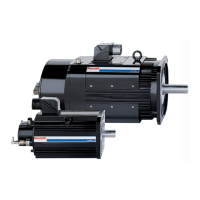Rexroth IndraDyn A Application Notes 9-15
Servo Applications
An electrically-released holding brake is used to hold the axes at a
standstill and when the “controller enable (rF)” signal is off. When the
power supply voltage is lost or the rF-enable signal is LOW, the
electrically-released brake will automatically close (engage).
⇒ Do not use the holding brake as an service brake for moving axes.
If the brake is engaged repeatedly on a drive in motion or the rated brake
torque is exceeded, premature brake wear can occur.
The electrically-clamping holding brake is inappropriate for servo
applications, because clamping in a de-energized clamping state is not
possible.
Dimensioning of Holding Brakes (Application)
The physical conditions of holding brakes require consideration of two
states. In addition to normal operation, fault conditions must also be
considered. The effective braking torques are physically different.
Normal Operation
In normal operation, i.e. using the holding brake for clamping of an axis
at standstill, the brake’s static-torque (M4) rating in the data sheets
applies - directly as static holding torque (M4) - static friction (friction
coefficient
µ
H
).
Fault Condition (EMERGENCY STOP)
In fault conditions (i.e., EMERGENCY STOP), i.e. when the holding
brake is used to stop a moving axis, the ”dynamic braking torque”, or
sliding friction applies - friction coefficient
µ
G
.
The dynamic braking torque is reduced in comparison to the indicated
static holding torque M4. Therefore, note the following description of
dynamic dimensioning.
The load torque must be smaller than the minimum dynamic torque which
the brake can provide. Otherwise the dynamic brake torque is not
sufficient to stop the axis.
If a mass is to be decelerated in a defined time or in a defined route, the
additional mass moment of inertia of the whole system must be taken into
account.
Electrically-released Holding
Brake
Dynamic Dimensioning

